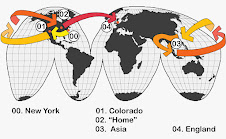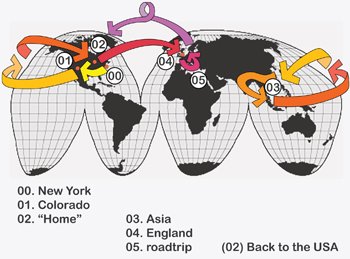My $2 Lao t-shirt shows the numbers in their non-latin based form
In each country we visit, we try to learn the basics of the language: thank you, please, excuse me, husband/wife, and 1-10/100. We've found that our probably silly-sounding attempts to speak like locals prompt more smiles than anything else we can do. It's amazing how a previously tired-looking Cambodian woman will smile when we try to repeat back in Khmer the price she's just given us in English. Of course, the biggest laughs are when we don't know the word and act if out. Josh's "brrrr" motion for a cold soda has gotten a laugh in every country so far.
Read the rest...
(Un)fortunately, learning the language in many of these countries is unnecessary if you know English. Most venders, restaurant servers, taxi drivers, and hotel staff speak the necessary English phrases (imagine a Vietnamese women and a Korean man bartering in English, another reason we are greatful to be American- our native language is English) , but we tend to think the reward for our efforts (a smile, more respect maybe) seems well worth it. Most natives seem especially tickled when we know the words for husband and wife.
Thank you and hello don't take too long to remember, but I have found that numbers are more difficult for me as they are learned in sequence but never used as such. I've found my crash courses in counting to be surprisingly interesting though, and here are a few thoughts on a topic I've rarely considered before (and Josh wonders why I'm bothering to write a post on them at all), the numbers one through ten:
- Not staying long in Laos, we weren't sure it was worth the effort to learn to count. Then we looked at our little Lonely Planet phrase book and realized that with a few tonal differences, the numbers are the same in Lao and Thai with the exception of the number 20. I didn't realize the languages were so similar.
- I am fascinated by Cambodian numbers. You only need to know 1 through 5 and then they repeat themselves until you get to a new word for ten: five-one is six and five-three would be 8. Brilliant! It gets a bit lengthy, but it sure is easy for a foreigner! Plus they all start with "B", which makes for a pleasing little tongue-twister.
- All these languages are still 10-based. Alright, you mathmeticians, anthropologists? Why?
- When I learned Spanish, I thought it was odd that the low teens were their own numbers, as they are in English. The same is often true here. Instead of ten-one or ten-three, there's a whole new word or at least the "one" part of it changes. Wierd.
- Each language, with the exception of modern Vietnamese, has a different symbol than our latin ones. I thought it was odd that they didn't seem to logically build off each other (getting progressively more complicated or something) until I realized that my own numbers are just as arbitrary! Thank goodness their currencies now tend to include the latin number as well.


No comments:
Post a Comment